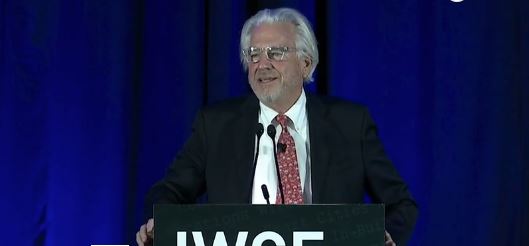O’Brien proposes clearing 50 MHz of LMR spectrum to support private-broadband services
Wireless entrepreneur Morgan O’Brien proposed that private-radio licensees should consider voluntarily pooling LMR airwaves below 1 GHz to create 50 MHz of spectrum dedicated to private broadband services, or they risk losing longtime enterprise customers to commercial carriers offering low-latency 5G services.
During his keynote address delivered last week at the IWCE 2021 event in Las Vegas, O’Brien expressed his belief that 5G services will have a profound impact on the “Fourth Industrial Revolution,” which depends on near-real-time connectivity to deliver IoT, automation and remote capabilities that promise to drive efficiencies for enterprises.
Such applications will depend on wireless connectivity that can deliver latencies of 3 milliseconds or less—a threshold that even the most robust LMR systems will never be able to reach, O’Brien said. This reality is the driving force behind the proposal to repurpose LMR spectrum for wireless broadband, he said.
“Without the extensive availability of wireless broadband there is no Fourth Industrial Revolution,” O’Brien said in his keynote address. “My next logical step is to posit that, without an allocation of broadband spectrum exclusively for enterprise, the opportunity for wireless broadband—and all of its benefits—will be severely curtailed.
“And not just any spectrum will suffice. To provide ubiquitous broadband coverage throughout the country and effective penetration of buildings, a foundation of spectrum from below 1 GHz will be essential.”
O’Brien quickly noted that no such spectrum is readily available today and—if the FCC were to “discover” available airwaves—current policies mean the frequencies likely would be auctioned to the highest bidder, which historically is almost always a commercial network operator.
Commercial carriers are in the process of deploying 5G, with the lowest-latency services—often utilizing millimeter-wave spectrum that supported very limited coverage—often targeted toward enterprise users. Almost 100 years of private radio have demonstrated that many enterprises favor the control and independence they can realize with private networks, but the compelling use cases of the Fourth Industrial Revolution could result in enterprises turning to carriers, if that is the only option for 5G connectivity, O’Brien said.
“If wireless broadband is as critical to next-generation enterprise as many of us think, then there is no reason to think that the users who traditionally prefer private spectrum for their own systems will be willing or able to wait for some new private spectrum to come along,” O’Brien said. “It would be a very long wait.
“Instead, the commercial wireless carrier—you’ve got to love them—will be the best available alternative, and they’ll take these customers away from the traditional vendors, dealers, and operators. Preservation of this important marketplace choice may therefore be in great peril. That is the ‘why’ of my call to action.”
And that call to action would result in LMR licensees working cooperatively to make a proposal to the FCC that their narrowband spectrum be repurposed to support the type of wireless broadband services that would be needed to compete with carriers for prized enterprise customers seeking to leverage Fourth Industrial Revolution technologies, according to O’Brien. And the LMR spectrum would not have to be reconfigured into a single contiguous swath to enable broadband, he said.
“It’s very important to realize that 5G technology can aggregate spectrum across bands, such that swaths of spectrum from across the land-mobile bands—say VHF, 450 MHz, 800 MHz and 900 MHz—if cleared to become available, could be combined to produce a unique and substantial broadband segment exclusively for the Private Radio Services,” O’Brien said. “Here, LTE, 5G and whatever comes next could be deployed.
“If—and I know it is a huge, huge ‘if’—we could clear half of the approximately 90 to100 MHz of spectrum previously allocated and in use for decades by the Private Radio Services, then we could ‘free up’ and deploy through spectrum aggregation, a powerful 50 MHZ of broadband nationwide. All of the tremendous propagation and penetration characteristics of below 1 GHz would position this spectrum as the bedrock spectrum to facilitate the unimaginable values and benefits of the Fourth Industrial Revolution for industry.”
O’Brien said that a key condition to the LMR industry working to clear so much spectrum should be that the spectrum would be designated for private-network use, as opposed to being auctioned to carriers.
Historically, the FCC has focused its spectrum-policy decisions around the notion of spectral efficiency, with a notable preference for broadband technologies in recent years. With this background, O’Brian said he believes that “today’s FCC is sufficiently enlightened” to accept a deal from private LMR licensees.
“The bargain is: Private Radio gets to keep the spectrum, which has been allocated to it for decades, on the condition that it voluntarily repurposes over time such that we clear this broadband spectrum; and the FCC changes the rules to optimize enterprise broadband as the foundational building block for the Fourth Industrial Revolution,” he said.
“On that spectrum, LTE, 5G and whatever comes next will be implemented nationally, privately, for the exclusive use of private radio services, subject to the direct design and control of the industrial, agricultural, manufacturing, transportation users—you name them—who make up this universe.”
O’Brien acknowledged the difficulties associated with making his proposal a reality. Not only is the proposal almost unprecedented—normally, the FCC initiates a proceeding to repurpose spectrum, as opposed to industry proposing it—but there is a natural resistance to change, and the logistics associated with repurposing the spectrum likely would take several years.
Indeed, it took the FCC more than five years to conclude a proceeding and rule in May 2020 that LMR spectrum licensed to Anterix—a company with a board chaired by O’Brien—could be repurposed into a 3×3 MHz swath of LTE spectrum that is being used to provide private broadband connectivity to utilities pursuing smart-grid visions.
O’Brien’s latest proposal is significantly more ambitious and complicated, by comparison. The Anterix 900 MHz spectrum was largely vacant and was much smaller. In contrast, most of the 50 MHz spectrum targeted in the latest O’Brien notion boasts multiple incumbents nationwide, each with different priorities and adjacent-channel interference concerns.
Some industry sources questioned whether sub-1 GHz spectrum would be ideal for ultra-low-latency applications, as well as the potentially very complicated logistics surrounding the proposed spectrum clearing. Others questioned the timing of the proposal, noting that completing a complicated FCC proceeding could take so long that the window for realizing the enterprise business opportunities could close before this new 50 MHz of spectrum would become a factor.
But even the most critical sources noted that industry should not summarily dismiss this O’Brien spectrum proposal, based on the success of his past wireless visions and history of realizing opportunities through various forms of spectral reconfiguration.
Not all of them have turned out exactly as planned, but O’Brien has been instrumental in the creation of Fleet Call—a company that became Nextel Communications—the notion of the FirstNet nationwide public-safety broadband network (NPSBN) and the 900 MHz private-broadband service now being offered by Anterix. O’Brien also helped negotiate the core tenets of the 800 MHz rebanding agreement, although Nextel Communications was sold to Sprint before any of that reconfiguration work was done.

















